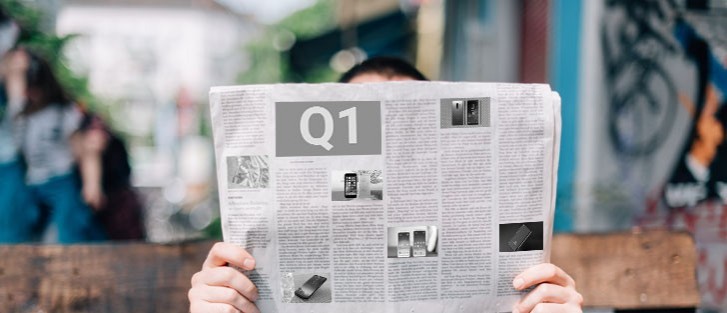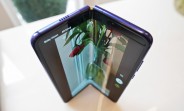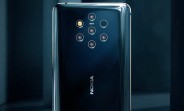As the year winds down it's a great time to reflect on the top stories of the past 12 months. This is the first of four installments where we look at the stories that shaped this year.
The first quarter of the year is a very important one. It hosts the Mobile World Congress in Barcelona, where we usually see a lot of the flagship phones that will shape the mobile landscape until the summer.
But this year we got more than the usual square slabs of premium tech. MWC gave us our much-anticipated glimpse of the first foldable phones!

Samsung and Huawei showed off, initially at a distance, the Galaxy Fold and the Mate X. We were present at both events and came away giddy with excitement - something of a rarity for seasoned techies such as ourselves.
Samsung had the upper hand on Huawei as it was able to release units to the press for preliminary reviews. However those promptly uncovered a few hardware issues - the hinge behind the folding screen would accumulate dirt and debris, which would ultimately destroy the device. There was a thin film over the display, which some mistook for a screen protector and attempted to peel it off, resulting in damage to the screen.
This led to Samsung recalling all Galaxy Fold devices in the field and cancelling all pre-orders of the device. At the time it wasn't clear if and when Samsung would resolve the issues, but we now know that it took it months to do so. Samsung officially re-launched the Galaxy Fold in September with a number of improvements and seemingly no critical flaws.
Meanwhile Huawei's Mate X wasn't ready for release until late November but it only got a limited release due to Huawei's issues with the US goverment.
Some of the most important devices of early 2018 was the Galaxy S10 lineup (consisting of vanilla, plus, e and 5G models). There were a number of high-profile leaks before the Galaxy S10 quartet eventually arrived on February 20.
We learned most of the specs through a leak, which we ourselves delivered first. The 12GB/1TB variant of the Galaxy S10+ leaked and we learned that the Galaxy S10e won't be called Galaxy S10 Lite.
When Samsung announced its Galaxy S10 lineup it brought the first HDR10+ screens, first ultrasonic under-display scanners, a new triple camera among other things.
Another big MWC announcement was the Nokia 9 PureView. The penta-cam phone was long in the making and captured the attention of everyone.
It promised to deliver the ultimate dynamic range on a smartphone camera but it failed to win the fans over. It lacked an ultrawide or telephoto camera, nor did it have great battery life and was already behind the curve with its Snapdraon 845 chipset. But it did impress us with its incredible bokeh rendition in macro and portrait photos.
Another big announcement during the MWC was the Sony Xperia 1. Initially rumored as the Xperia XZ4, the Xperia 1 redefined Sony's flagship and brought another name change.
But the Xperia 1 was much more than just a name. It's the only flagship with a 21:9 4K OLED screen on the market and its 12MP regular + 12MP tele + 12MP ultrawide camera combo proved to be among the best in the market.
In March Huawei unveiled its P30 and P30 Pro to compete with Samsung's Galaxy S10 and S10+ head on. The Huawei P30 Pro's secret weapon was the 5x periscope telephoto camera. It wasn't great for video and it was subpar in low light but damn that baby could zoom.
Samsung's new Galaxy M series launched at the end of January and proved quite popular. The Galaxy M10 and M20 were aggressively priced and brought dual cameras, Infinity-V displays and capable Exynos chips. The Galaxy M20 had a 5,000mAh with 15W charging.
Xiaomi showed off a foldable design but it failed to materialize into a device in 2019. However the company released one of the most popular phones of the year in the Redmi Note 7. It brought the right blend of great price and good specs. This was one of the first 48MP cameras on the market and non-coincidentally one of the most successful phones of the year.
And Xiaomi's novel ad campaign which saw the Redmi Note 7 mash watermelons, smashing walnuts and being used as a cutting board was quite enjoyable.
Meizu unveiled the Zero prototype with no physical buttons and not even a speaker or charging port. It was an interesting concept but remained just that - a concept. Meizu couldn't pull off the crowdfunding needed to take the Zero off the ground.
And while we're on that sentiment, Windows Phone received its official final call in January 2018. Microsoft will continue to support Windows Phone until the January 2020, but then it's officially dead.
That's it for our Q1 recap. Stay tuned for Q2.
Xiaomi's interesting ad campaign, showcasing the durability of the new affordable device continues with even more silly videos.
The 6.47" AMOLED screen gets next-gen in-display FP reader as well as acoustic display tech. Kirin 980 and 40W charging round off this flagship.
The first-ever smartphone penta-camera is also the first smartphone camera to use the Light computational photography system.
The wide notch of the original was not everyone's favorite feature, so what if it's replaced by a more palatable waterdrop notch?
It is powered by Snapdragon 855 SoC with up to 12 GB RAM.
Dynamic AMOLED replaces Super AMOLED. The S10 phones also feature faster wireless charging and PowerShare.
It has a 4.6" phone screen, 7.3" tablet screen and six cameras dotted all over. The Fold will be available on April 26.
The Nokia 9 PureView could potentially have the best scene depth-sensing around as our first camera samples show.
HMD has brought us a true PureView successor - the Nokia 9 with its five 12MP snappers and a ToF camera at the back.
This is the "Beyond 1", aka the 6.1" curved screen model. The S10 series will not have gradient color paint jobs, says another rumor.
This is the end of a beloved smartphone platform as Microsoft shifts efforts to support its services on the two majority platforms.





























0 Response to "Top stories of 2019: Q1"
Post a Comment